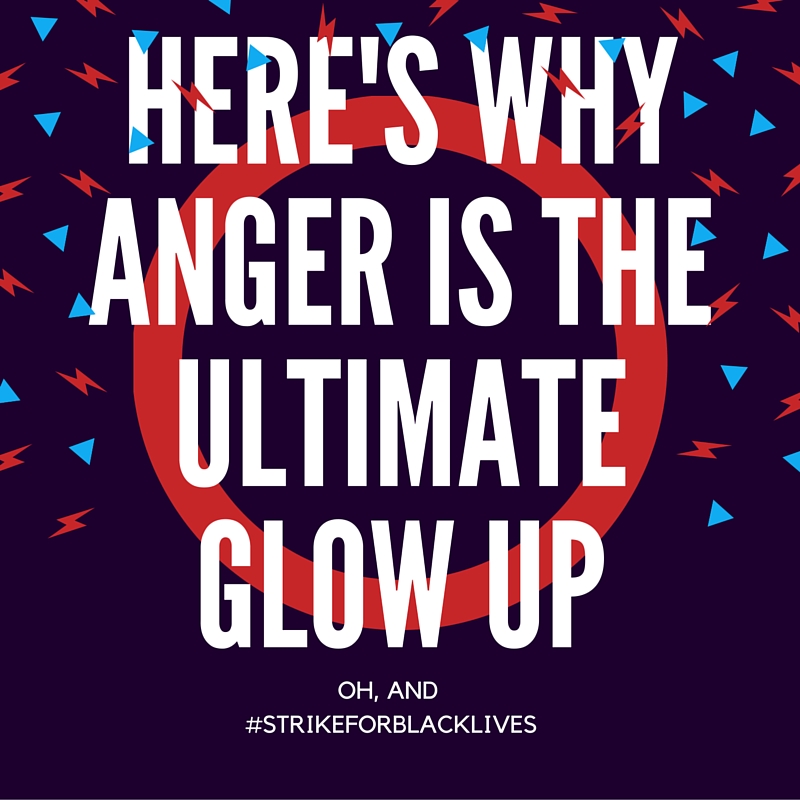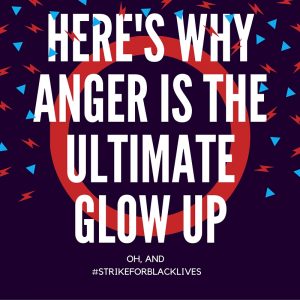
One of my favorite podcasts is Another Round, featuring a writer for Buzzfeed, Tracy Clayton and a writer for the Stephen Colbert Show, Heben Nigatu. The show features guests of color talking about a wide range of subjects, but with a keen eye on culture. One part drunken conversation and one part reportage, Another Round offers a black and female perspective on the world around us. At the end of each episode Tracy and Heben “pour rounds” for something or someone. This week, Tracey poured a round for “anger.”
That’s right. “Anger.”
Here’s what she said: “Shout out to the drinking, cussing, smoking, baseball bat swinging, ain’t having none of your shit, “First of all, this is what you not gone do,” talking ass women, because we are the ones who get shit done [emphasis mine].”
As an emotion, anger, especially among black women, is a neglected access point. Even the community of black people police each other’s anger. This has been a real argument among black activists of different generations. “Peace” and “anger” are painted as polar opposites.
Young activists are implored to protest “peacefully,” and when the press wants to compliment a protest, they call it “peaceful.”
But don’t you have to get angry to protest?
I must reiterate, anger is an access point. It is a way to evolve. Anger is an emotional glow up. Anger can take you to the next level.
Anger gets a bad rap in American cultural discourse, and that should be a “red flag,” (pun intended) because the other items that received a bad rap from the perspective of American white supremacy were freedom from enslavement and literacy.
There was a time when black people in this country were told that freedom wasn’t all it was cracked up to be. Enslavers routinely lied to slaves about people who’d run away, telling them how bad they were doing in the north. That’s what Frederick Douglass was told.
Speaking of Frederick Douglass, he also accessed his anger. He beat the shit out of a man he’d been rented out to. That moment he took back his body was the moment he became truly free. You should read it here.
Enslavers also talked about literacy and how it wasn’t for black people. They said it ruined us. Frederick Douglass was told learning to read would only make him discontented. And who wants a discontented slave?
Black people’s anger is on the radar, though. And just like FREEDOM and LITERACY, the truth about our ANGER is being purposely and systematically disambiguated.
We are told we are consumed with a seething anger because our parents didn’t “insist we do our homework every night;” not because Philando Castile was murdered by a police officer, and in his town blacks made up almost 50% of the traffic stops while being only 7% of the population.
Black elites say say we’re really angry because of how our killing of each other has “taught them [police] how to treat [kill] us.”
But they still haven’t acknowledged the report on mappingviolence.org that reveals “there is no correlation between the rate of police killings and the rates of communal violence in the top 20 cities. In layman terms, that means that the black communities with the highest percentage of communal violence are not the cities with the highest number of state sanctioned killings of black people.” (Traci Blackmon, Pastor and expert on righteous anger)
Of course, my supreme example of productive anger is Fannie Lou Hamer. In 1964 Fannie Lou Hamer arrived at the Democratic national convention ready to register her complaint about the intimidation and murder of black voters publicly. She was met by Hubert Humphrey who begged her to not be honest on camera. Who implored her to submerge her concerns about black life until Lyndon Johnson was elected. The real boogie man was Nixon, he said.
Sound familiar?
The Democrats told Fannie Lou Hamer “shhh” at the convention in 1964. They said the terrorized and murdered black folks that you represent will be addressed after the real goal, which is getting LBJ elected. They offered her a ceremonial seat to not stand up and show Mississippi’s drawers. She retained ownership of her anger. She told it all. On camera. She did not stand with Emmett Till’s mom, and Medgar Evers’ wife and say “Vote for LBJ.”
There would not be a civil rights bill if Mrs. Hamer had not delivered this riveting testimony.
Hubert Humphrey tried to give Fannie Lou Hamer respectability in exchange for her anger. But he couldn’t erase the image of sexual assault and beating she and her comrades had received from her mind. She had traveled too far and had been through too much to trade in her evolution for a pin, a flag, and a ceremonial seat.
Like the civil rights movement of the 1960’s, today’s movement is made up of thousands of decisive moments like the one Fannie Lou Hamer made famous in 1964.
Today, #StrikeForBlackLives offers a moment like that one. According to the website, #StrikeForBlackLives is “a nationwide work strike . . . Slated to begin the day after labor day, and last the remainder of the week, #StrikeForBlackLives asks US to have AT LEAST ONE day of absence (Tuesday, September 6) which is the #BlackFolksOffDay. The remainder of the week can be taken off if you can RISK or AFFORD it. The minimum sacrifice is ONE DAY of work strike and ONE WEEK of economic boycott.”
The website goes on to explain:
“Clear “demands,” action steps and ways forward have been submitted at the national level. In 2014, after the death of Michael Brown, (and the incredible pressure of young people in the streets), President Obama convened the President’s Task Force on 21st Century Policing. Their report is here.
The Black Lives Matter movement throws its support behind Campaign Zero, which has a policy solutions focus which is brilliant in its simplicity.
Until person’s accountable and dates are added to any of these examples, however, they are, essentially, wish lists.
In order to turn police reform from a list to an actionable directive, there must be ACCOUNTABILITY, and there must be CONSEQUENCES. A nationwide black labor strike and economic boycott, would in the words of Martin Luther King, “create a situation so crisis packed that it will inevitably open the door to negotiation.”
To my mind, #StrikeForBlackLives is a moment. It is a gateway to evolution. No more protests strategically planned for weekends. Let’s interrupt American commerce and show them that there can be no business as usual as long as black and brown people can be murdered without redress.
We owe it to the young to get angry in front of them.
Here recently, Killer Mike exemplified a way forward using targeted, productive anger in his now viral interview.
He says a lot of things. He says, “It’s time to get angry.” He talks about controlling the economic narrative in the black community as a way to build wealth and a way to protect black lives.
One of the more brilliant parts of the interview (of which there are many) is the comparison he draws between the U. S.’s current dynamic and an abusive relationship. He says, “[It’s] like a woman who’s getting beat on by a man saying he’ll see he’s hurting me eventually. A lot of those women end up dead.”
To continue the comparison, in an abusive relationship, the low self esteem subverts anger and privileges the tactic of constantly appealing to the abuser’s “better nature.”
It is not black people’s responsibility to create catharsis for white people. To reveal their “better nature” to them. But it is our responsibility to ensure the survival of our children.
To end, Malcolm X introduced Fannie Lou Hamer once and in his introduction he spent a bit of time comparing African liberation struggle with black American liberation struggle. He said, “I noticed that in the areas where independence had been gotten, someone got angry. And in the areas where independence had not been achieved yet, no one was angry. They were sad—they’d sit around and talk about their plight, but they weren’t mad. And usually, when people are sad, they don’t do anything.”
Let’s use our anger to get shit done.
Let’s #StrikeForBlackLives.